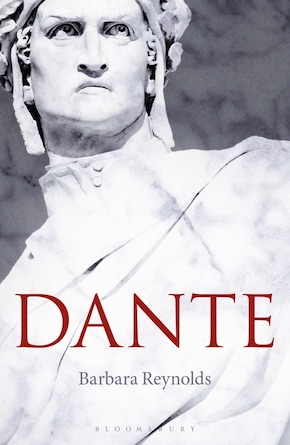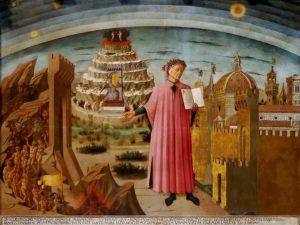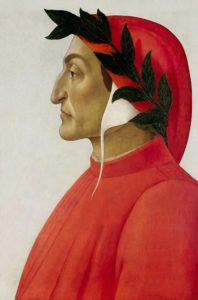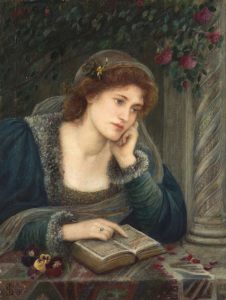Dante’s nose
by Mika Provata-Carlone
“Scholarly and seductive… This wonderful biography will compel you to read Dante if you have not already done so, and if you have, to read him again.” Financial Times
Early in the morning of September 1321, Dante died of malaria in Ravenna. Looking at the images (pictorial or sculptural) that we have of him, and considering the corpus of his work, especially the impact he was to have on our understanding of European culture in the centuries to come, one would think this would be a man well advanced in years. His works are formidable, truly tremendous, unsurpassably epic; he looks, what is more, everlastingly stern, full of steely gravitas, undeviatingly determined, almost forbiddingly unyielding. Some, like E.M. Forster, who would describe him as a man “with terrifying jaws and sunken eyes”, found him perhaps somewhat otherworldly, even beyond the realm of the human. There is something immeasurable about his physical and intellectual presence, enhanced, certainly, by the lucco, the emblematic Florentine cape of office, that Cosimo de’ Medici would try and bring back into fashion about a century later as a way of enhancing the city’s cultural sovereignty, and the wreathed cap he invariably dons; a sense of commanding monumentality, even in the representations that are meant to capture him at his most intimate creative moments, like the Dante we have from Giotto, Andrea del Castagno or Lucca Signorelli. In fact, at the time of his death Dante was only 56. Yet he had managed to fill every unforgiving minute to the brim.
He had met with triumph and disaster, fame and infamy, and, for all that, he was indomitable in his aspirations for glory in perpetuity. It would not come immediately (as it did not come easily during his lifetime). Many private persons and whole cities, the state itself, as well as the church, were fumingly furious with him across Italy (if not even further beyond its boundaries), for his treatment of them in his unsparing, magnificent, although not yet divine Commedia. Before Boccaccio could publish his famous biography of him in 1351, prohibitions would be issued against the reading of his works; an eminent theologian would denounce him as a vas diaboli, the devil’s own advocate. His books would be burned, and Petrarch himself would feel that it might not be quite political to commit himself too publicly in Dante’s favour. Formal reconciliation with the church would have to wait until 1921, and with his beloved Florence until 2008, when an official apology was issued for his exile, and the accusations against him, as well as his sentence, were revoked. Interestingly, the motion for his rehabilitation was passed by the council of Florence with a majority of 19 votes for, and 5 against. However one chooses to look at it, this is unquestionably a long journey of return from exile, and yet, as Francis J. Ambrosio would write in Dante and Derrida, Dante’s most celebrated work is “the gift of pardon, given par don, given in exile, by exile, to exile.”
It is a detailed cultural and intellectual map of the times, and a gripping intertextual reading of Dante’s works, interlacing fine scholarly detail with universal themes and emotions.”
The experience, trauma and opportunities indirectly or directly afforded by Dante’s political exile from Florence lie at the heart of Barbara Reynolds’ Dante: The Poet, the Thinker, the Man, a book that is so much more than the sum of its parts. A lavish vita, it is also an extraordinarily vivid and incisive chronicle of the dynamics and titanic clashes in Italian and European political life at the time, the momentous changes in society, state structures and religion, in the very understanding of human individuation, and of a singularly empowered social engagement. It is a detailed cultural and intellectual map of the times, and a gripping intertextual reading of Dante’s works, interlacing fine scholarly detail with the universal themes and emotions that have made Dante’s words almost archetypal for Western consciousness.
Reynolds strolls uncannily between our present and Dante’s past, creating very tactile, sensory perspectives on history, intellection, ordinary or exalted lives, and the complexities of new urban realities. She has a particular talent for limning the passing of time, the ends of eras, or the blessed (perhaps relentless) continuity of existence. We get a feel for the throbbing pulse of contemporary family life and human relations at every level, from intimate whispers and bawdy verses or scurrilous political invectives to formal epistolary exchanges and imperial or papal decrees. She infuses her text with a pungent flavour of social polemics, tensions and brittle balances, of death and life. She takes us into Dante’s schoolroom as a child, scans his shelves for his first books: he was taught his manners from a manual by the title of Facetus, and apparently he was not the most assiduous of pupils, although he certainly did catch up rather impressively in later life; he might, just might, have heard the lectures of Fra Remigio de’ Girolami, who had studied Aristotle with Aquinas in Paris, and would perhaps shape Dante’s own political thought, and it was Brunetto Latini who “taught him the art ‘by which men become immortal.’” Guido Cavalcanti, patron, intellectual companion, proto-Virgilian guide, and irreplaceable male friend, emerges as one of Dante’s central enigmas, and as a key to so much of who he was and came to be.
Yet Dante was not only books and idealism. Besides his love for music, his great (perhaps professional) skills in painting, his studies in philology, philosophy, theology, numerology, astronomy, history, languages, perhaps pharmacology and constitutional and civic law, he was also trained “in horsemanship for battle, and in the use of the lance, the sword and the mace.” He took part in bloody battles, where he had “done his share of hacking and slicing” and he may have slain “the Ghibelline warrior, Buonconte da Montefeltro.” He was a deft diplomat and negotiator, a relentless political opponent, an intractable ideologue, a man whose tongue as well as his sword could sting and deliver deadly blows. He was also not quite the Sir Galahad that popular perceptions of his admiration for Beatrice might suggest: Dante was intensely carnal as well as spiritual, brutally fierce as much as he was elegiac. Ambitious, enterprising, a go-getter with a particularly strong confidence in his skills and merits, he was a boon drinking companion relishing the tight bonds of the society of the Fedeli d’Amore, to which he belonged with his fellow poets, an exuberant composer of ribald canzoni, as well as of aubades and lovers’ ballads, and somewhat of a ladies’ man. Reynolds hints boldly at scandals, including a wish list of desirable women, no fewer than sixty, where Beatrice features in ninth place and his proclaimed, unnamed favourite du jour as number thirty. There are rumours of transcendent states that are more psychedelic than metaphysical, and of experiments with reality-enhancing substances, stories of plots and subterfuges, of numerous comforting maidens, influential patrons, confessions of loneliness, poverty, disgrace, despair. She weaves together Dante’s everydayness with his sublime nachleben, and she also reveals that we can raise a glass to Dante’s memory at the Villa Serego Alighieri in Gargagnano di Valpolicella near Verona, an estate bought by his son Pietro in 1353. The descendants of Il Sommo Poeta still live there and, if we are to believe their own claims on their website, make rather fine wine.
Reynolds evinces a shrewd eye for interiority and for engrossingly reflective readings, as well as for flamboyant spectacle, for she has theatre and the stage in her blood.”
Reynolds’ Dante is sensitive, sensual, sentient, an extraordinary mind and a busy political strategist, an inscrutable or reluctant husband, dreamy poet, formidable ingenio. Her story is at the same time the rich distillation of a long academic life and scholarship, deeply informed by a genuine love for learning and for teaching, and a gesture of cinematic bravura, drama and high suspense. Reynolds evinces a shrewd eye for interiority and for engrossingly reflective readings, as well as for flamboyant spectacle, for she has theatre and the stage in her blood: her father was a conductor and composer who studied with Engelbert Humperdinck (of Hansel and Gretel), her mother was an opera singer and composer; her paternal grandfather was the owner of the ‘Reynolds Exhibition’ in Liverpool, a waxworks display that included live entertainment and freak shows. Never compromising the quality of her discourse, she invests it with a scintillating sense of audience, context, stagecraft and desired impact. She presents us with life in Dante’s time as well as with Dante’s life, composing a finely layered text for both, revealing them each as throbbing, teeming with energy (for good or evil), overflowing with portents of glory or catastrophe. The nuts and bolts of Dante’s poetry are interwoven with the bare (dire) facts of history, through detailed portraits of common or aristocratic Florentines, tableaux of everyday scenes, from women flirting in the streets to feasts and the anxious quest for income, to guilds that promoted one’s advancement. She singles out the public artworks, especially the religious representations, such as the frescoes in Florence’s Baptistry, that were formative for Dante’s ethics, aesthetics and ontology; she also highlights the equally public rituals of executions that Dante would have witnessed, and which would inspire so much of his poetic imagery (such as the live burial of assassins, head stuck in the ground, legs dangling above, exposed), as well as providing, for us, a radical understanding of the burning sense of urgency that he felt regarding judgement and justice, both human and divine. As she notes, “the devils and torments of the Inferno are not Dante’s own inventions. Such terrifying warnings were not only displayed in frescoes and mosaics, they were recited in rhyme by street entertainers, they were the subject of sermons and they were enacted” in festivals. As in the case of Homer, Dante’s genius, the quality that makes him unique in the use of such shared historical and cultural material, is this talent in shaping the received experience into an inimitable individual voice that seeks to grasp the limit and limitlessness of our humanity, our strengths and weaknesses, our fatalistic dreams and woes of horror.
Reynolds above all is a biographer, a Dante scholar who is keenly engaged with her subject in a relationship of critical companionship. She seeks to understand him, admire him, share him with us, while being always unflinching in her academic instincts. She is unafraid to be reverently irreverent, taking Dante to task when his ‘superbia’ overrides his genius, which seems to have happened rather frequently: “By the time he wrote Il Convivio, he had come to believe that he understood God’s plan for the world, and that he, a descendant of the ‘godlike citizens’ of Rome [Dante believed he could trace his ancestry to the Elisei, a patrician Roman family and the founders of Florence], was destined to reveal it.” Another scholar, Teodolinda Barolini, has identified this as Dante’s Arachne complex, and it requires no further comment from Reynolds: the questioning rhetoric, the analytical stance and the invitation to a personal answer regarding the fine line between genius and hubris are all there. It is an example of how, throughout Dante, rather than using scepticism or resorting to devotee adoration, her focus is on interested, insightful, truly critical engagement.
This approach of combining objective observation with a personal insight and voice makes this life of Dante a particularly pleasurable read, for all the meticulously close readings of some of the goriest episodes of both life and fiction – or perhaps it does so especially because of the sensitivity in contextualising them. Reynolds discourses eloquently along the way on theology, eschatology, political science and philosophy, Dante’s preoccupation with pure race and ancestry, the right to a cultural, national, historical heritage, and in particular the tensions between blood aristocracy and a rising merchant class, which frame his concentrated attack against presumed privilege, whilst retaining the notion of one perfect system of government, namely a sovereign empire that would bring about a medieval version of what he saw as the highest virtues of the Pax Romana under the sign of the Christian God. She provides a singularly clear analysis of the feud between Ghibellines and Guelphs, and between Guelphs Black and White, evokes the church and state politics of papal elections with engrossing vividness and currency, and shows how both central and marginal Dante eventually was to the fate of his homeland and to his own. She has a rare skill for bringing historical figures to life, for making us listen and for allowing her readers the freedom to stray from her chosen path by striking a fine balance between description and prescription, and she can weigh with sharp precision each moment of her narrative so that it satisfies without encroaching, enlightens without indoctrinating, intrigues without lessening the value of her subject through popularisation.
Her focus on the Commedia reveals the poem’s dynamic evolution, the electrifying current of convictions and contradictions that run through it, the ‘in process’ nature it has from the beginning. In the chapters dedicated to the poem’s story, she shows us especially Dante as a developing individual and persona, the transition from anger, bitterness, an almost vitriolic perspective of intense ratiocination and great historical localisation and specificity, to something that defies his own boundaries or even vision. Reynolds does not opt for a quick survey, but rather reads the Commedia with us, showing us first of all, in the flesh and in the words, Dante the showman, who “was obliged to turn [after the failure of Il Convivio] to a more successful kind of entertainment: the story of a journey into the world of the dead investing what was a primitive form of pop art with the dignity [of a loftier tradition and meaning] and making it a vehicle for his own profound ideas, [thus creating] a new form of literary art which this time held his audience and has continued to do so ever since.” From biographer and literary historian, she moves further, echoing Dante’s mind, evoking the thrill and the inspired frenzy of conceiving and composing as vast and complex a vision and design. She does not rush, but paces herself and us, building suspense, tracing clear paths, as well as opening up a thousand diverging roads that lead to long-unresolved riddles and not a few new, astounding revelations.
Beatrice emerges a full-blooded woman of her class and time, temperamental, unyielding, with an almost proto-feminist thrust in her discourse, as well as a remarkably vigorous mind and intelligence.”
Her analysis of Beatrice, the real-life woman, the idol, the voice we never really hear since it is overtaken by Dante’s own, is particularly poignant, debunking century-old mythographies and revealing a far more robust and complex character than much of the Commedia’s reception has allowed for, including Botticelli’s ethereal illustrations. She emerges a full-blooded woman of her class and time, temperamental, unyielding, with an almost proto-feminist thrust in her discourse, as well as a remarkably vigorous mind and intelligence. In many ways, she is a foil, “in one of her roles, she is the voice of Dante’s [own] intellect” as well as the ideal of love, spirituality, a particular theological vision. She is perhaps even a Kate to his Petruchio.
Reynolds relishes the process of revealing to us the intricate, highly mathematical architecture of the poem, the incantatory rhythms that rely heavily on sounds, language and magical numbers, and which attach the verses to memory as well as providing “a safeguard against alterations by copyists.” “The effect is that of a woven fabric” that cannot be unravelled, a universal and transcendental human history that cannot be disclaimed. It is binding, even a bondage in many ways as Reynolds reveals, as well as superbly spellbinding. She shows us Dante’s revolutionary strategies regarding language, and the way that he captures and incarnates the sublime using the simplest, most ordinary (often most unpoetic) words and turns of phrase, thus transforming fundamentally the role of poetry, the power of the imagination, by performing what is almost literally an act of transubstantiation; she draws out his radical positions regarding politics and government, his maverick status, his darkness and fallacies. She picks up Tolkien’s suggestion that he was a man “full of spite and malice. I do not care for his petty relations with petty people in petty cities” and adds to it the dialectics of Dante’s own torments, traumas and tragedies, his Promethean failings and extraordinary wisdom. She holds several tantalising tricks up her sleeve to hold the attention of even the most straying of minds, such as the Commedia’s explanation regarding the formation of the continents: long before human time, the totality of the mainland surface was concentrated in the southern hemisphere, the rest of the globe being covered with water. It separated into tectonic plates, frantically anxious to shift and move away from one another, when Lucifer, cast off from Heaven, collided with the terrestrial ground. In horror, the land split and the fragments moved away northwards, thus forming the new face of the planet.

La Divina Commedia di Dante by Domenico di Michelino, 1465, at Florence Cathedral. Wikimedia Commons
1921 was a big year for Dante, even though he was not perhaps aware of it. (He apparently participated in various seances around that time, so perhaps one may allow for a margin of doubt as to that point…) It was not only the 600th anniversary of his death, but also the year when the Catholic Church would finally and officially readmit him into its busom. Benedict XV, having reread De Monarchia and the Inferno, had found sufficient expiatory reasons that allowed him to reassess Dante’s treatment of the Pope and the Church in both texts. Dante could once again be reclaimed as one of the Catholic Church’s very own, and vast celebrations were carried out across Italy, including commemorative stamps, and yet another exhumation of Dante’s bones. The purpose was for them to be studied, especially his skull, to establish once and for all the extent of his brilliance and the true weight of his genius. There had been a previous attempt to study Dante’s bones in 1865, when they were triumphally rediscovered behind a wall in St Francis’ Convent in Ravenna, on the 600th anniversary of his birth. In this second attempt, though not without a significant amout of fuss and opposition, the Italian anthropologist Fabio Frassetto took detailed measurements of Dante’s skull, noting the disappearance of Dante’s lower jaw bone, the one E.M. Forster so dreaded (in a seance dedicated to the question of the missing mandible, Dante apparently declared that it was, after all, of no importance, and the search for it ought to stop). A new likeness of Dante emerged, as the measurements were compared with existing credible portraits. The equiline nose was permanently lost, somewhat following the fate of the corresponding part of the Egyptian Sphynx; the features, always portrayed with maximum emphasis on those elements deemed to indicate unyielding determination, masculine resolve, a higher, commandeering intelligence, were equally softened, splitting the world of Dante scholars, and those who loved both the man and his poetry, into multiple antagonistic factions.
This is a riveting account of Dante the man in all his manifestations, his infinite pluralism and idiosyncrasy, but equally of Dante the phenomenon, the creature of our own, and of so many previous generations.”
In 2004, in celebration of the presumed date that marks the start of the Commedia’s composition, Frassetto’s measurements were called upon once more, resulting in an arresting 3-D bust by Francesco Mallegni portraying a very different man – almost suavely congenial, playfully humorous, certainly intensly intellectual, a little more physically or otherwise indulgent. In many ways, this is the man looming over Reynolds’ pages (although not necessarily over the cover: the first edition of Dante featured Luca Signorelli’s meditative fresco from the Orvietto Cathedral; the current edition boasts the more petrifying 1865 marble statue of Dante from the Piazza Santa Croce by Enrico Pazzi). Yet another encounter with Dante’s physical remains is scheduled for 2021, on the 700th anniversary of his death, and one wonders what new reality, material, allegorical or metaphorical, may be there to greet us this time. Barbara Reynolds would certainly not have been uninterested to witness the occasion, even if she might have been sceptical as to its sanctity and the very frutifulness of the project. Her own Dante is a very fine tribute for the new centenary, for those who might wish to revisit Dante in her company. Never dryly archaeological, invariably intelligent, this is a riveting account of Dante the man in all his manifestations, his infinite pluralism and idiosyncrasy, but equally of Dante the phenomenon, the creature of our own, and of so many previous generations. First published when Reynolds was 91 (she died at the age of 100), this is also a work of distinct maturity and assurance, though never of self-indulgence, presumption or arrogance. It has the fullness of a legacy of learning, the feeling of a very long friendship and companionship – with Dante, with Dante’s readers, with a world that Reynolds clearly believes is full of wonder, for all its adversities, flaws, or sheer darkness and human absurdity.
 Barbara Reynolds (1914–2015) was one of the world’s best-known Dante scholars. She completed the Penguin translation of Paradiso after the death of Dorothy L Sayers. She also translated Dante’s early work La Vita Nuova and Ariosto’s Orlando Furioso for Penguin Classics. In addition, she wrote a biography of Dorothy L Sayers and was General Editor of The Cambridge Italian Dictionary. Dante: The Poet, the Thinker, the Man is published by Bloomsbury Academic.
Barbara Reynolds (1914–2015) was one of the world’s best-known Dante scholars. She completed the Penguin translation of Paradiso after the death of Dorothy L Sayers. She also translated Dante’s early work La Vita Nuova and Ariosto’s Orlando Furioso for Penguin Classics. In addition, she wrote a biography of Dorothy L Sayers and was General Editor of The Cambridge Italian Dictionary. Dante: The Poet, the Thinker, the Man is published by Bloomsbury Academic.
Read more
@BloomsburyAcad
Mika Provata-Carlone is an independent scholar, translator, editor and illustrator, and a contributing editor to Bookanista. She has a doctorate from Princeton University and lives and works in London.



